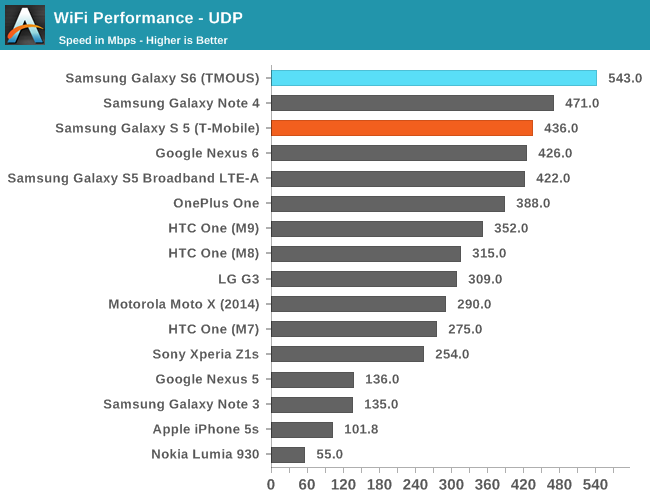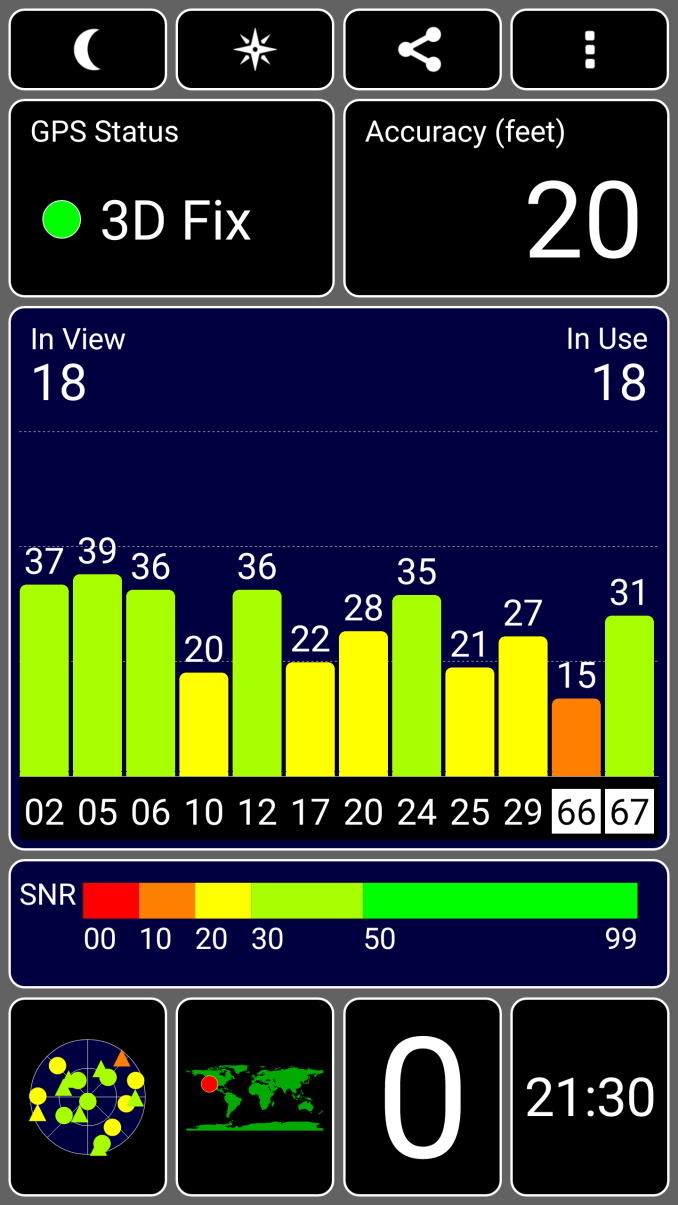The Samsung Galaxy S6 and S6 edge Review
by Joshua Ho on April 17, 2015 9:00 AM EST- Posted in
- Smartphones
- Samsung
- Mobile
- Galaxy S6
- Galaxy S6 Edge
WiFi Performance
As WiFi is still quite important on a smartphone for anyone on a relatively limited data plan, it's also important to test how well a device behaves when using WiFi. In order to do this, we use our standard iperf test to see how fast the device can send UDP packets. In the case of the Galaxy S6, we see that it shares the same BCM4358 WiFi/Bluetooth combo chipset that we first saw in the Galaxy Note 4. As always, in order to ensure maximum possible performance we're using an Asus RT-AC68U router to avoid issues with the router bottlenecking the phone.

As we can see, the Galaxy S6 manages to do better than anything else we've been able to test in recent memory. I'm not sure what's causing the difference in performance when comparing against the Note 4, but it's definitely possible that the antenna configuration has been improved to increase coherence and therefore the performance benefit that comes from MIMO.
GNSS Performance
In most of the Galaxy S6 variants, as there is no Gobi modem that could be used to provide GNSS location services it seems that Samsung has turned to Broadcom to provide satellite location services. In the case of the Galaxy S6, we see a Broadcom BCM4773 location chipset. This includes support for all of the major constellations including GPS, Beidou, and GLONASS in addition to SBAS, which helps to improve accuracy beyond what conventional GPS satellites can provide. To get a good idea for how good this system is I tried testing how long it took for a lock to happen on a clear night with airplane mode on. The Galaxy S6 managed to acquire a lock in 20 seconds which is likely to be a warm lock but a cold lock will likely take a minute without assistance data. After an additional 20 seconds I saw a peak accuracy of 20 feet, so there shouldn't be any notable issues with the GPS system. For the Galaxy S6 CDMA variants it's likely that location will be done using the MDM9x35 Gobi modem rather than the Broadcom solution used in the GSM Galaxy S6.
Misc
For the Galaxy S6, Samsung has fundamentally uprooted how they traditionally design their phones, and in the case of the entire radio architecture this is especially true. Instead of the standard Qualcomm modem, we see that Samsung has moved to the Shannon 333 GSM/LTE modem for the Galaxy S6 GSM variants. Given that this is likely to be the same modem that is in the Note 4 LTE-A it’s likely that this modem will ship as category 6, while we have reason to believe it's ultimately capable of UE category 9. However, whether the RF front-end is capable of handling 3x carrier aggregation of up to 450 Mbps on the downlink is a different question and is likely to be one that we won’t know the answer to unless support is added in an OTA update.
The transceiver, envelope tracker, antenna tuner, and most of the components that would traditionally be Qualcomm parts in a Snapdragon-equipped phone have also been replaced with Samsung Shannon components based upon the Chipworks teardown. In general though, I didn’t notice any issues with this choice of RF components although judging by the use of Qualcomm modems in the CDMA variants it’s likely that such a move was necessary in order to ensure good RF performance on CDMA networks but not GSM networks due to Qualcomm’s experience with CDMA2000. It's likely that anyone that has had previous experience with the CDMA Galaxy Nexus would be able to attest to this.
Unlike some other variants, we’ve noticed that the Galaxy S6 T-Mobile variant uses an Audience eS804 voice processor to enable hot word detection and S-Voice launching and is likely also active in phone calls and in any other scenario where noise cancellation and voice processing would be beneficial. The T-Mobile variant that we received also uses an NXP PN547 NFC module rather than a Samsung NFC module, but we did confirm that there is an ST-M digitizer used for the touchscreen and a Cypress CapSense PSoC for the capacitive keys.
Although I still don’t have the equipment to test speakers properly, subjectively the audio quality of the Galaxy S6’s single downward-firing speaker is good. The volume gets high enough that I never really used it on maximum volume for videos, but it’s still annoying to have to cup my hand to ensure that sound is going towards my face rather than traveling away. Overall the M9 still has much better speakers for a good media experience, but there’s nothing wrong with the speaker on the Galaxy S6 for casual use. I definitely found myself using it less than the front-facing speakers on the M9 though.











306 Comments
View All Comments
JoshHo - Friday, April 17, 2015 - link
Something similar to the APx582 would be necessary to test 3.5mm output accurately, and a good SPL meter would help with speaker quality although I'm not sure results for the latter would be comparable between editors.IsthatyouBevis - Friday, April 17, 2015 - link
Wow, that camera comparison is really poorly done. Trying to compare what you seem to think are the 2 best cameras (iPhone 6+ and S6) was extremely difficult. Why do you present the galleries in such a way as it is impossible to determine which picture to click to see which phone and why can't we see them clearly in the same page, instead of the click fest you force us to go through? Surely there is a better way to demonstrate this?johnnohj - Friday, April 17, 2015 - link
1. Were these photos taken with Auto-HDR enabled? If I am not mistaken, both the iPhone and S6 ship with Auto-HDR turned on by default. Those impressive low-light photos Samsung showed at the unveiling were taken with Auto-HDR enabled.2. Can immersive mode (full-screen) be disabled on Samsung apps like Calculator and S-Planner?
3. Were there any problems with RAM management like in this video https://youtu.be/hUw9PUlFUF0?t=1m32s where the S6 keeps killing apps in the background? It could explain the poor battery life some people are experiencing as apps would have to be killed and reloaded all day.
4. Can heads-up notifications be disabled?
5. I wish there was a way to test standby battery usage. It is something android phones have always been poor at compared to iPhones. How about a test where the x most popular apps (like Facebook, Gmail, WhatsApp, Instagram, Twitter with the same accounts, sync enabled) are installed to multiple test devices on the same wifi network and the battery usage is measured after x hours?
6. Why does Samsung still include the Quick Connect and S-Finder buttons in the notification slider? It's so annoying, and there is no way to disable them without root (except on a few US carrier versions).
Hrel - Friday, April 17, 2015 - link
No sd card is pretty bad, but being Samsung is worse.khujin - Friday, April 17, 2015 - link
I just tested GS6 edge 64GB and Androbench4.0 result is 320MB/s(seq. read), 140MB/s(seq. write) with default setting. And another website GS6 performance review it the same as mine. please check the UFS test.JoshHo - Friday, April 17, 2015 - link
The default sequential test does 32MB sequential reads which is wildly unrealistic at best. As shown in the storage performance section we test using 256KB reads and writes for sequential performance.heartinpiece - Saturday, April 18, 2015 - link
Nice review Joshua! I don't see any Ipad Air 2 performances in the performance charts (although they are constantly referenced...) could you check on the graphs?Peichen - Saturday, April 18, 2015 - link
Seems like there are only 2 company making real flagship phones now: Apple and Samsung. To achieve this status, buying off-the-shelf parts are no longer good enough. You need to custom order parts and optimize the software specifically for the parts. From SoC, memory, screen to camera, everything is custom ordered to achieve the best quality. Off-the-shelf phones like M9 and Nexus 6 are relegated to good $500ish phone status.On the other hand, it is sad to see Samsung abandon all its believes and completely adapted Apple design and philosophy. Nano-SIM, downward speaker, simplified camera UI, fingerprint magnet back, home-button scanner and the abandonment of colorful UI and screen tone. Samsung users always love the punchy screen color. What are they going to say now the school is color corrected like iPhone display?
Peichen - Saturday, April 18, 2015 - link
screen*Impulses - Saturday, April 18, 2015 - link
Maybe, I think LG or Sony could still step up to the plate... Sony's got a whole bunch of outside issues threatening the future of it's phone division tho, and probably their budget. Which is a shame because they made the only SMALL flagship phone last year in the Z3c.The bigger issue at play might be that a good chunk of the market is now complacent with their $500 or less also-rans, and another sizeable chunk is just buying outgoing models instead of the current hotness. Otherwise the SGS5 should've sold even better than the 4, and it had every right to based on hardware alone.
I'm part of that segment tbh, huge Android fan, initially went thru three successive HTC phones year after year... Not really feeling that upgrade bug anymore, at all. I'd like better battery life than what my N5 offers, and/or water resistance, can live without either for now.
My phone isn't my main camera so I'm an exception there but I don't think the average buyer even realizes what makes for a better camera or reads AT to find out.